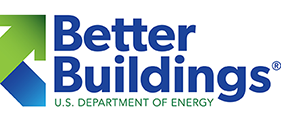by Brianna Crandall — May 24, 2021 — According to a new report, the U.S. Department of Energy (DOE)’s Better Buildings Initiative, in collaboration with nearly 1,000 business, government and other partners, saved $13.5 billion in energy costs and more than 130 million metric tons of carbon emissions in the past year — equivalent to the greenhouse gases emitted by 28.2 million vehicles in a single year. These building efficiency improvements are said to be key to reaching President Biden’s goal of net-zero carbon emissions by 2050.
Secretary of Energy Jennifer M. Granholm remarked:
Through Better Buildings, leading organizations across the U.S. are demonstrating their commitment to use energy more efficiently. In partnership with DOE, they are sharing the solutions needed to tackle our climate crisis, create jobs, and build healthy, safe and thriving communities.
Since 2011, the Better Buildings Initiative has partnered with leaders in the public and private  sectors to make the nation’s homes, commercial buildings, and industrial plants more energy efficient by accelerating investment upgrades and products and sharing best practices.
sectors to make the nation’s homes, commercial buildings, and industrial plants more energy efficient by accelerating investment upgrades and products and sharing best practices.
The 2021 Better Buildings Progress Report outlines the progress and collaboration of Better Buildings partners, which represent more than 30 of the country’s Fortune 100 companies, 12 of the top 25 U.S. employers, 12% of the U.S. manufacturing energy footprint, and 13% of total commercial building space, as well as 17 federal agencies, 8 national laboratories, and more than 80 states and local governments. The report also highlights the 12 organizations that achieved their Better Buildings Challenge energy, water or financing goals in the past year.
DOE also announced launching the Low Carbon Pilot, with more than 50 leading partners, including automakers, foodservice companies, universities, and local governments, working with DOE to share their experiences, successes, and challenges pursuing low-carbon strategies. The lessons learned help DOE and the broader energy market better understand the dynamics of emissions reduction, energy efficiency, cost savings, and resilience. Find the full list of partners participating in the Low Carbon Pilot online.
During the Better Buildings Summit, the annual meeting of partners and stakeholders, DOE also launched the latest iteration of the L-Prize, a $12 million competition to spur the development of next-generation LED lighting fixtures. The new L-Prize incentivizes manufacturing and installing these fixtures in the United States — creating jobs and reducing energy use, carbon emissions and costs for American businesses and consumers. The first L-Prize, which was awarded 10 years ago to a LED replacement for the 60-watt bulb, helped lay the groundwork for products that now save Americans $14.7 billion in avoided energy costs per year.
Additional highlights from the Better Buildings Progress Report include:
- Financing for energy efficiency projects: Financial Allies, working with DOE, have extended more than $26 billion to date for energy efficiency and renewable energy projects across a range of sectors and communities.
- Generating savings through energy management: Partners in the Smart Energy Analytics Campaign closed out 2020 with a projected $95 million savings for participants annually through energy management information system technologies and ongoing monitoring practices.
- Increasing public and private better buildings partnerships: More than 400 organizations are part of the Better Buildings Residential Network, which has completed nearly 300,000 home energy upgrades in the past year.
- Recognizing high-performance and healthy buildings: Green Lease Leaders are modernizing leases to spur collaborative action on energy efficiency, cost savings, improved air quality, and sustainability across nearly two billion square feet of building space. This DOE initiative is in partnership with the Institute for Market Transformation.
Learn more about DOE’s Better Buildings Initiative and read the Better Buildings Progress Report on the DOE website.





